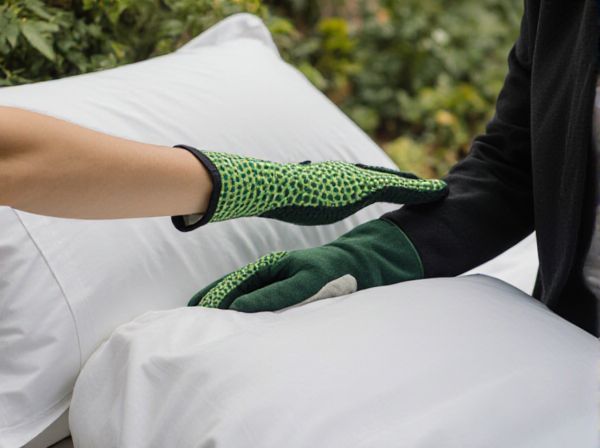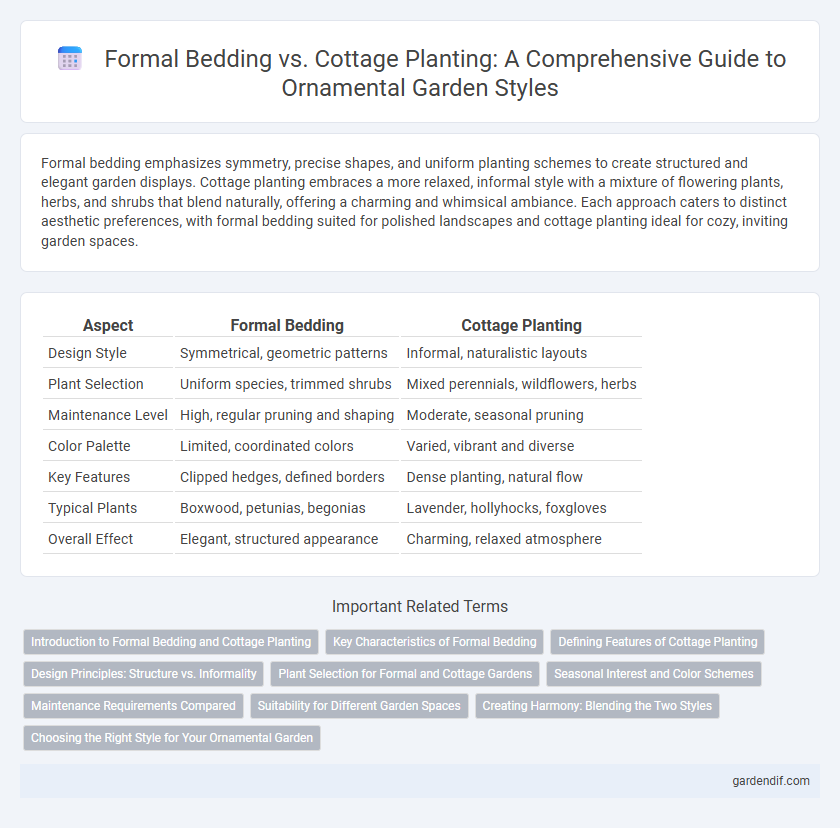
Formal Bedding vs Cottage Planting Illustration
Formal bedding emphasizes symmetry, precise shapes, and uniform planting schemes to create structured and elegant garden displays. Cottage planting embraces a more relaxed, informal style with a mixture of flowering plants, herbs, and shrubs that blend naturally, offering a charming and whimsical ambiance. Each approach caters to distinct aesthetic preferences, with formal bedding suited for polished landscapes and cottage planting ideal for cozy, inviting garden spaces.
Table of Comparison
| Aspect | Formal Bedding | Cottage Planting |
|---|---|---|
| Design Style | Symmetrical, geometric patterns | Informal, naturalistic layouts |
| Plant Selection | Uniform species, trimmed shrubs | Mixed perennials, wildflowers, herbs |
| Maintenance Level | High, regular pruning and shaping | Moderate, seasonal pruning |
| Color Palette | Limited, coordinated colors | Varied, vibrant and diverse |
| Key Features | Clipped hedges, defined borders | Dense planting, natural flow |
| Typical Plants | Boxwood, petunias, begonias | Lavender, hollyhocks, foxgloves |
| Overall Effect | Elegant, structured appearance | Charming, relaxed atmosphere |
Introduction to Formal Bedding and Cottage Planting
Formal bedding features symmetrical, geometric layouts with carefully clipped hedges and uniform plant groupings, emphasizing precision and order in ornamental garden design. Cottage planting contrasts this with informal, dense arrangements of diverse flowering plants, herbs, and shrubs, creating a naturalistic, romantic aesthetic characterized by spontaneity and vibrant color combinations. Both styles serve distinct purposes in garden ornamentation, reflecting varied horticultural traditions and design philosophies.
Key Characteristics of Formal Bedding
Formal bedding features symmetrical layouts with precisely clipped hedges and geometric patterns, creating a controlled and elegant appearance. Key characteristics include uniform plant spacing, vibrant seasonal flowers often arranged in intricate designs, and the use of topiary to maintain structure. This style prioritizes order and visual harmony, contrasting with the more relaxed and mixed planting seen in cottage gardens.
Defining Features of Cottage Planting
Cottage planting is characterized by a dense, informal arrangement of mixed perennial flowers, herbs, and shrubs that create a natural, overflowing garden aesthetic. Unlike formal bedding's symmetrical design and precise patterns, cottage planting emphasizes diversity, layering, and continuous bloom throughout the seasons. This style often incorporates traditional garden favorites such as foxgloves, hollyhocks, and lavender, enhancing its rustic charm and ecological benefits.
Design Principles: Structure vs. Informality
Formal bedding emphasizes symmetry, geometric shapes, and well-defined borders to create a structured and orderly garden appearance. Cottage planting embraces informality through dense, mixed plantings with varied heights and textures, promoting a natural and relaxed aesthetic. The contrast between the two lies in the intentional precision of formal bedding versus the spontaneous, layered approach of cottage planting.
Plant Selection for Formal and Cottage Gardens
Formal gardens emphasize structured plant selection with symmetrical, evergreen shrubs such as boxwood and yew, combined with neatly clipped hedges and seasonal bedding plants like begonias or pansies for color uniformity. Cottage gardens favor a diverse, informal mix of perennials and annuals including foxgloves, hollyhocks, and lavender, promoting a natural, abundant appearance with varied heights and textures. Choosing plants based on growth habit and maintenance ensures that formal gardens maintain order while cottage gardens capture a relaxed, whimsical aesthetic.
Seasonal Interest and Color Schemes
Formal bedding features symmetrical designs with precise seasonal rotations, emphasizing uniform color schemes like bold reds, whites, and blues that create striking visual impact. Cottage planting offers a more relaxed approach with overlapping blooms throughout the seasons, showcasing a diverse palette of pastel and vibrant colors that evolve naturally. Seasonal interest in formal bedding is crisp and predictable, while cottage planting thrives on informal layering and continuous blooms from spring through fall.
Maintenance Requirements Compared
Formal bedding requires meticulous maintenance, including regular pruning, precise edging, and frequent deadheading to maintain its structured appearance. Cottage planting demands less intensive care, favoring natural growth patterns and intermittent trimming to promote a relaxed, informal look. The labor investment in formal beds is significantly higher due to the need for continuous shaping and upkeep.
Suitability for Different Garden Spaces
Formal bedding suits structured, symmetrical gardens with clear lines and defined borders, often found in urban or smaller garden spaces requiring precise maintenance. Cottage planting thrives in informal, naturalistic settings, ideal for larger or rural gardens where plants can grow more freely and create a relaxed, colorful atmosphere. Choosing between the two depends on garden size, style preference, and desired maintenance level.
Creating Harmony: Blending the Two Styles
Formal bedding emphasizes symmetry, geometric patterns, and neatly trimmed hedges, while cottage planting features a more relaxed, natural arrangement with diverse, flowering perennials. Creating harmony between these styles involves using structured elements like boxwood borders to frame informal clusters of colorful, fragrant plants such as lavender and foxglove. Combining these approaches balances architectural precision with charming, organic softness, enhancing visual appeal and garden rhythm.
Choosing the Right Style for Your Ornamental Garden
Formal bedding features symmetrical arrangements and structured layouts, emphasizing clipped hedges and uniform flower beds to create a polished, classical appearance. Cottage planting embraces a more relaxed, informal style with mixed perennials and annuals, allowing for natural growth and a dense, vibrant display that attracts pollinators. Selecting the right style depends on garden size, maintenance preferences, and the desired overall aesthetic to achieve a harmonious ornamental space.
Formal Bedding vs Cottage Planting Infographic

 gardendif.com
gardendif.com